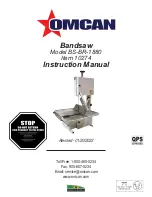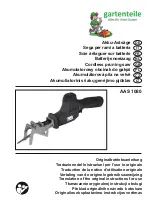
Making Miter Gauge Auxiliary Facing . . . .33
Push Block . . . . . . . . . . . . . . . . . . . . . . . .34
Auxiliary and Thin Workpiece Fence . . . .34
Blade Bevel Control . . . . . . . . . . . . . . . . .35
Extending Table Extension . . . . . . . . . . . .35
Pre-Cut Locator . . . . . . . . . . . . . . . . . . . .35
Using The Rip Fence . . . . . . . . . . . . . . . . . .36
Ripping . . . . . . . . . . . . . . . . . . . . . . . . . . .36
Bevel Ripping . . . . . . . . . . . . . . . . . . . . . .36
Using The Rip Fence Pointer
When Table Is Not Extended . . . . . . . . . .37
Using The Table Pointer When
Table Is Extended . . . . . . . . . . . . . . . . . . .37
Using The Miter Gauge . . . . . . . . . . . . . . . .38
Adjusting The Miter Angle: . . . . . . . . . . .38
Crosscutting . . . . . . . . . . . . . . . . . . . . . . .38
Repetitive Crosscutting . . . . . . . . . . . . . .39
Making The Repetitive Crosscut . . . . . . . .39
Miter Cutting . . . . . . . . . . . . . . . . . . . . . .40
Bevel Crosscutting . . . . . . . . . . . . . . . . . .40
Compound Miter Cutting . . . . . . . . . . . . .40
Non-Thru Cutting . . . . . . . . . . . . . . . . . . . . .41
Rabbeting . . . . . . . . . . . . . . . . . . . . . . . . .41
Dado Cutting . . . . . . . . . . . . . . . . . . . . . .42
Installing a Dado Set . . . . . . . . . . . . . . . .42
Using Stacked Dado Sets . . . . . . . . . . . . .42
Returning Saw to Normal Thru-Cutting . .44
Adjustable or Wobble Dado Sets . . . . . . .44
Installing a Molding Head Set . . . . . . . . .44
Returning Saw to Normal Thru-Cutting . .45
Special Cutting Techniques . . . . . . . . . . . . .45
Maintaining Your Table Saw . . . . . . . . . . . . .46
General Maintenance . . . . . . . . . . . . . . . .46
Lubrication . . . . . . . . . . . . . . . . . . . . . . . .46
Attachments . . . . . . . . . . . . . . . . . . . . . . . . .47
Troubleshooting . . . . . . . . . . . . . . . . . . . . . .48
Miter gauge template - for adding
mounting holes . . . . . . . . . . . . . . . . . . .155
3
Table of Contents
SAVE THESE INSTRUCTIONS
1. Work area safety
a.
Keep work area clean and well lit.
Cluttered
or dark areas invite accidents.
b.
Do not operate power tools in explosive at-
mospheres, such as in the presence of flam-
mable liquids, gases or dust.
Power tools
create sparks which may ignite the dust or
fumes.
c.
Keep children and bystanders away while op-
erating a power tool.
Distractions can cause
you to lose control.
d.
Make workshop child-proof with padlocks
and/or master switches.
2. Electrical safety
a.
Power tool plugs must match the outlet.
Never modify the plug in any way. Do not use
any adapter plugs with earthed (grounded)
power tools.
Unmodified plugs and matching
outlets will reduce risk of electric shock.
b.
Avoid body contact with earthed or grounded
surfaces, such as pipes, radiators, ranges and
refrigerators.
There is an increased risk of
electric shock if your body is earthed or
grounded.
c.
Do not expose power tools to rain or wet con-
ditions.
Water entering a power tool will in-
crease the risk of electric shock.
d.
Do not abuse the cord. Never use the cord for
carrying, pulling or unplugging the power
tool. Keep cord away from heat, oil, sharp
edges or moving parts.
Damaged or entangled
cords increase the risk of electric shock.
e.
When operating a power tool outdoors, use
an extension cord suitable for outdoor use.
Use of a cord suitable for outdoor use reduces
the risk of electric shock.
f.
If operating a power tool in a damp location
is unavoidable, use a Ground Fault Circuit In-
terrupter (GFCI) protected supply.
Use of an
GFCI reduces the risk of electric shock.
g.
Before connecting the tool to a power source
(receptacle, outlet, etc.), be sure voltage sup-
plied is the same as that specified on the
nameplate of the tool.
A power source with
voltage greater than that specified for the tool
Read all safety warnings, instructions, illustrations and specifications pro-
vided with this power tool.
Failure to follow all instructions listed below may
result in electric shock, fire and/or serious injury.
SAVE ALL WARNINGS AND INSTRUCTIONS FOR FUTURE REFERENCE
The term “power tool” in the warnings refers to your mains-operated (corded) power tool or
battery-operated (cordless) power tool.
General Power Tool Safety Warnings
1600A01Z1U.qxp_4100XC 10/31/19 1:21 PM Page 3




































